HIGHLIGHTS: OCTOBER 4, 2024
• Port strike gets tentative resolution
• Indonesian reverse trade mission to Wisconsin
• USDEC testifies at Colombian CVD hearing
• Letter seeks full RUTF funding
• USDEC at FAO ag committee meeting
• Meeting U.S. dairy export stakeholders in Oregon
• Market Summary: WMP lifts GDT
• Fonterra announces results, strategy plan
• Danone invests in India
• Company briefs: Beston, Junlebao, Yum China, Saputo
Featured
Dockworkers reach tentative agreement, head back to work
Members of the International Longshoremen’s Association (ILA) are headed back to work today after the union reached a tentative wage agreement with the U.S. Maritime Alliance (USMX). Late on Thursday, the union agreed to extend the contract it had with USMX until Jan. 15, 2025—with its members back on the job while the final details of a full agreement are worked out and the deal is ratified by the rank-and-file. Should the members vote against the deal, the strike could start once again. USDEC and NMPF welcomed the end to the strike and urged the parties to swiftly conclude the contract negotiations.
USDEC urges government action
Prior to the tentative deal, USDEC reiterated a call for the Biden Administration to immediately intervene in the strike, warning that such a disruption could have a devastating impact on American dairy farmers and exporters who rely on the smooth functioning of these ports to get their products to international markets.
“Global customers depend on the reliability of U.S. dairy products,” said President and CEO Krysta Harden in a joint USDEC/NMPF press release. “Delays caused by this strike not only risk damaging those relationships but also severely impact perishable dairy products that require timely delivery. Our reputation as a reliable supplier is on the line, and the administration needs to ensure that port operations resume immediately.”
On Wednesday, USDEC and NMPF then co-signed another letter to President Biden along with more than 270 other agricultural, manufacturing, retail and other supply chain stakeholders urging the administration use its authority to end the strike. Given the “massive ramifications for our industries and the economy, we implore you to take immediate action to resolve this situation expeditiously,” the letter states.
USDEC also issued a Member Alert on Oct. 1 that provides reminders and advice about routing shipments through Canada. USDEC has also been sharing information related to rerouting, storage needs, and stuck shipments to USDA. Please contact Tony Rice (trice@nmpf.org) if you have questions. (CNN, 10/3/24; Supply Chain Dive, 10/1/24; The Loadstar, 10/1/24; The Canadian Press, 9/30/24)
USDEC continues Indonesian engagement during reverse trade mission to Wisconsin
USDEC helped organize a reverse agricultural trade mission from Indonesia to Wisconsin this week with dairy as the centerpiece. The mission was funded and led by the National Association of State Departments of Agriculture (NASDA) and the Wisconsin Department of Agriculture, Trade and Consumer Protection (DATCP). Seventeen representatives from the Indonesian government, farm sector, food manufacturing and universities visited U.S. dairy farms, dairy processors, the University of Wisconsin’s Center for Dairy Research and the World Dairy Expo, which was taking place this week in Madison. Stops included Dairy Farmers of America (DFA) member Hinchley’s Dairy Farm and USDEC member Milk Specialties Global.
The mission represented the latest in USDEC’s enhanced engagement work with Indonesia in support of the country’s school milk program (see Global Dairy eBrief, 6/28/24). USDEC is looking to assist with President-elect Prabowo Subianto’s campaign pledge to provide nutritious meals and milk to all Indonesian school children, pregnant mothers and young children. That support comes in two ways: 1) Providing educational outreach to Indonesia’s small-scale farmers by collaborating with leading academics and dairy cooperatives on a technical training program. 2) Supporting expanded local UHT milk production with greater milk powder exports from U.S. suppliers. USDEC worked closely with NASDA and DATCP to help develop the invitee list and agenda for the week in order to assure that it complemented both those goals of the overall engagement strategy.
The trip provided education and exposure to both efforts. USDEC’s Krysta Harden, president and CEO; Jonathan Gardner, senior vice president, Market Access and Regulatory Affairs; Shawna Morris, executive vice president, Trade Policy and Global Affairs; and Vikki Nicholson-West, senior vice president, Global Ingredients Marketing, represented USDEC for various portions of the agenda throughout the week.
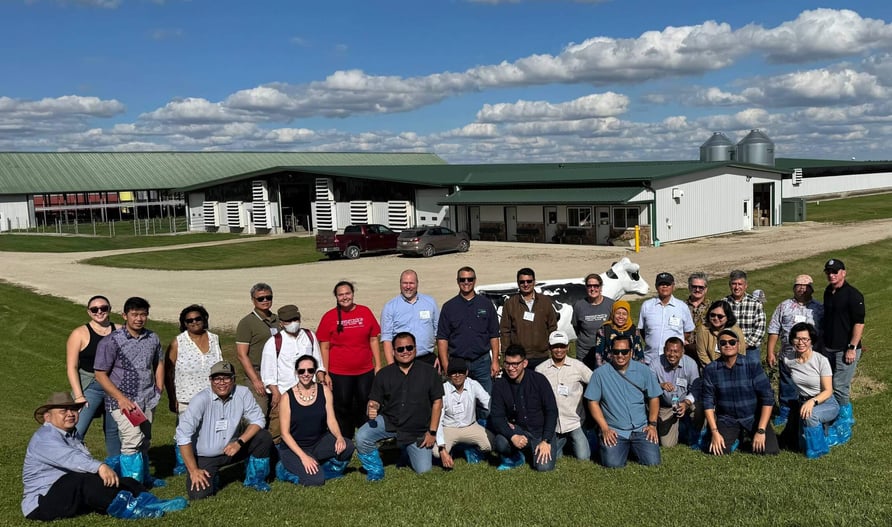
USDEC’s Jonathan Gardner, Shawna Morris and Vikki Nicholson-West with the Indonesian delegation, Wisconsin Agriculture Department, and NASDA members participating in the reverse trade mission at DFA member Hinchley’s Dairy Farm in Cambridge, Wisconsin.
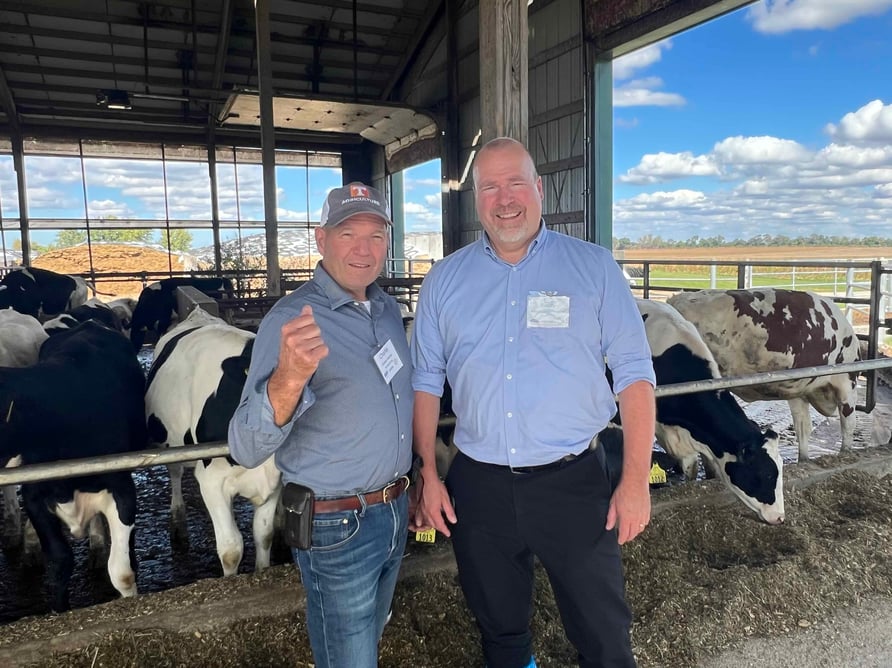
Left to right: Tennessee Ag Commissioner Charlie Hatcher and Wisconsin DATCP Secretary Randy Romanski at Hinchley’s Dairy Farm.
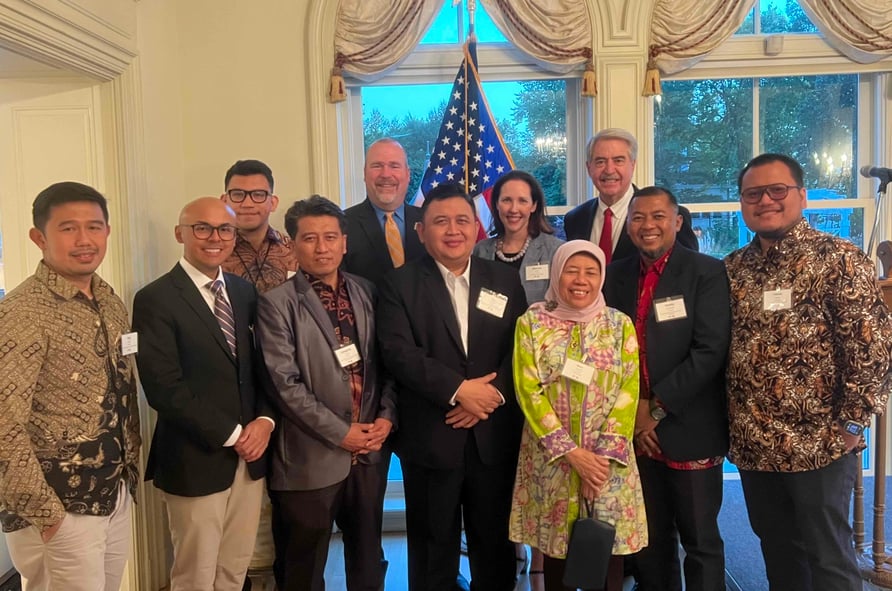
The reverse trade mission included a reception at the governor's residence. Several members of the Indonesia delegation pose here with (back row, right to left) Ted McKinney, CEO of NASDA; Shawna Morris, USDEC executive vice president, trade policy and global affairs; and Randy Romanski, Secretary of the Wisconsin DATCP. Additional USDEC staff were present but are not pictured.
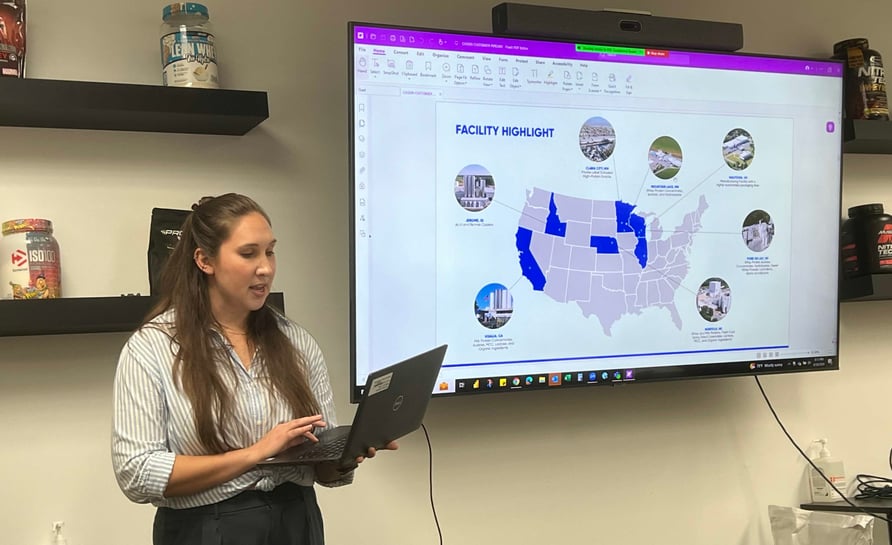
USDEC member Milk Specialties Global was one of the Wisconsin dairy companies that hosted the delegation. Here Jamie Miller provides a rundown of the company’s plant network.
USDEC testifies at Colombian CVD hearing
On Thursday, the Colombian government held a virtual hearing on its Subsidies and Countervailing Measures (CVD) investigation to hear arguments in the case and evaluate written submissions. USDEC and member companies participating in the hearing demonstrated one more time that the Colombian investigations is baseless and should be dropped immediately. This is an additional response to Colombia, following USDEC’s answers to the CVD questionnaire in August, strongly refuting allegations that U.S. dairy exports are being unduly subsidized and causing harm to the domestic Colombian dairy industry (see Global Dairy eBrief, 8/30/24).
Executive Vice President, Policy Development and Strategy, Jaime Castaneda gave testimony at this week’s hearing, reiterating those arguments. Other testifiers also included Patti Smith of California Dairies Inc. and Martin Bates of Dairy Farmers of America.
Colombia implemented a preliminary 4.86% tariff on certain U.S. milk powder HTS Codes in September (see Global Dairy eBrief, 9/20/24).
For the next steps in the process, parties will submit their final written arguments and rebuttals in the investigation. Approximately two months following the date of the publication of the preliminary determination, Colombia will issue a document laying out the Essential Facts in the case; parties then have the opportunity to respond. Following that, the Foreign Trade Directorate will adopt a final decision and publish it in the Official Gazette.
Letter seeks congressional backing for RUTF funding
A coalition of 18 U.S. agricultural organizations and food producers, including USDEC and NMPF, sent a joint letter to the heads of the House and Senate Appropriations Committees urging their support on maintaining funding for ready-to-use therapeutic food (RUTF) at current levels in the fiscal 2025 appropriations bills. The letter comes as conference negotiations begin on the bills.
Increased funding for RUTF starting in 2022 has allowed the United States to significantly increase treatment of wasting in children around the world. Prior to 2022, the U.S. government allocated about $45 million or less to RUTF purchasing. In 2022, that budget was raised to $200 million, which was matched by philanthropic organizations, pushing the total funding to $577 million, enough to treat about half of the children suffering from wasting worldwide.
“Without sustained funding, RUTF treatment will return to previous levels of coverage with only one-in-four children receiving the life-saving care they need,” the letter says. “Ongoing support from Congress is essential to maintaining and building on the tremendous progress made over the last few years in averting child-wasting deaths.”
This is the latest in a series of letters USDEC and NMPF have contributed to and/or signed this year defending RUTF funding. RUTFs utilize a variety of U.S.-produced ingredients, including milk powder, peanuts, soybean oil/soy protein, sugar and a special vitamin mix. In 2023, production of U.S.-made RUTF totaled $123 million, and American farmers and RUTF manufacturers can expand production to meet more of the global need if additional resources are provided.
USDEC keeps tabs on busy dairy agenda at this week’s FAO Committee on Agriculture
The FAO Committee on Agriculture (COAG) met this week in Rome and USDEC was there to help safeguard U.S. dairy global priorities. In terms of setting food, agriculture and nutrition policy, the COAG is FAO’s most powerful committee—and it is heavily informed by the newly created Sub-committee on Livestock (SCL).
USDEC’s Janice Giddens, vice president, Sustainable Nutrition, was at the COAG meeting this week as well as the most recent SCL in July, where USDEC led a well-attended official side event that highlighted actions the U.S. dairy industry is taking to promote healthy soils, biodiversity, and nutrient-adequate diets. Tara Vander Dussen, a U.S. dairy farmer Global Dairy Platform Dairy Ambassador, is also attending the meeting and participating in related events.
At press time, the COAG meeting was still underway, but Giddens reported back on several developments, as well as matters USDEC continues to monitor.
Livestock plans
The COAG approved the SCL meeting report, which included plans to move forward with a global assessment of the contribution of livestock to food security, sustainable agrifood systems, nutrition and healthy diets.
It also approved recommendations related to a negotiated Global Plan of Action for Sustainable Livestock Transformation, which will have implications for U.S. production practices. The plan covers all livestock production systems and takes into account the discussions of the Global Conference on Sustainable Livestock Transformation of September 2023 and the comments provided during the SCL. Stakeholder consultations will begin soon to inform the plan, and USDEC will ensure the U.S. dairy industry perspective is considered throughout the consultative process.
Key topics under discussion
USDEC is engaging on several other of the COAG’s agenda items, including:
- FAO’s work on the use and management of plastics in agriculture, including the Voluntary Code of Conduct on the sustainable use and management of plastics in agriculture.
- FAO’s work on the climate change, biodiversity, and food security nexus, with a focus on promoting trade and U.S. dairy exports as agrifood systems solutions.
- FAO’s work on nutrition initiatives, including its collaboration with the United Nations Children’s Fund (UNICEF) and World Health Organization to measure and monitor healthy diets at scale, via the Healthy Diets Monitoring Initiative (HDMI). HDMI aims to achieve this by raising awareness, developing guidance for healthy diet monitoring, implementing a prioritized research agenda, and facilitating the uptake and use of metrics for assessing and monitoring diets.
A new day to celebrate milk
The COAG was expected to approve a new International Day of Milk, which will take place annually on June 1. Giddens and Vander Dussen will address the committee and call upon member states to pass the proposal. At press time, that vote was still pending. The intent of the International Day of Milk is to increase awareness of the importance of milk and dairy products to human nutrition, as well as of their social, cultural and economic value. USDEC, Global Dairy Platform and the International Dairy Federation all support the concept.
USDEC influence
USDEC’s involvement with FAO agencies in Rome, including the SCL and COAG, help position U.S. dairy as a leader in global sustainable food systems. USDEC will continue to seek out more opportunities to align with member state allies and strengthen relationships with FAO staff to reinforce that leadership position and improve market access opportunities for the U.S. dairy sector.
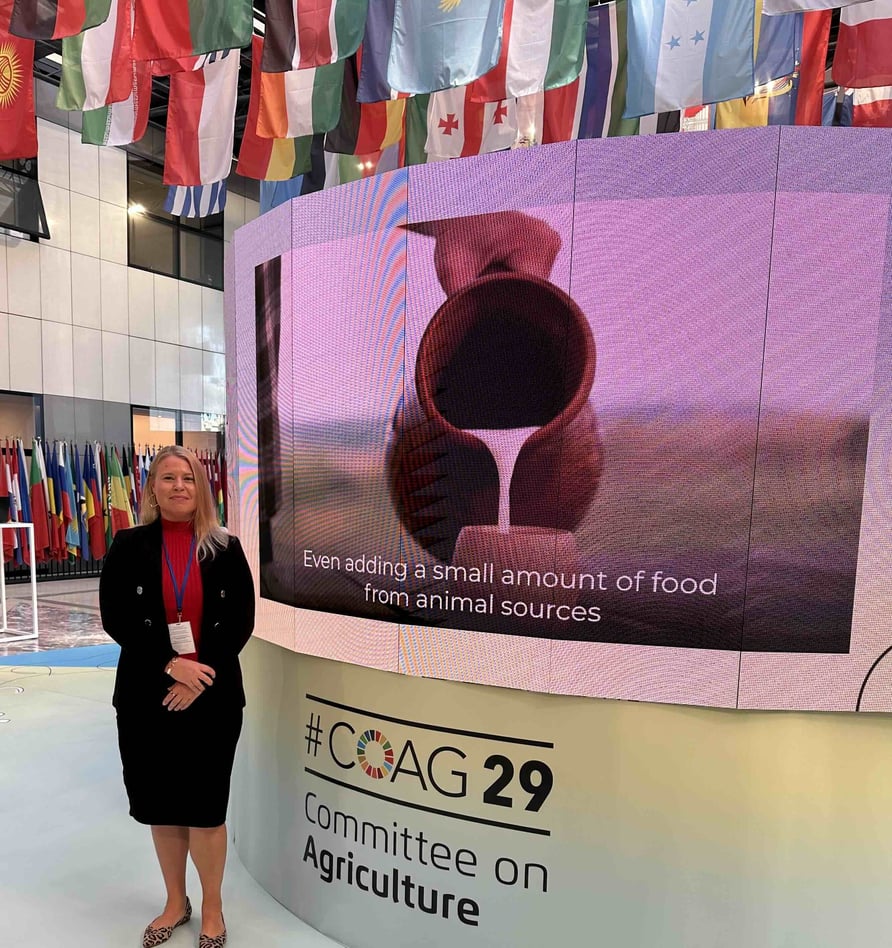
USDEC’s Janice Giddens at this week’s FAO Committee on Agriculture meeting in Rome.
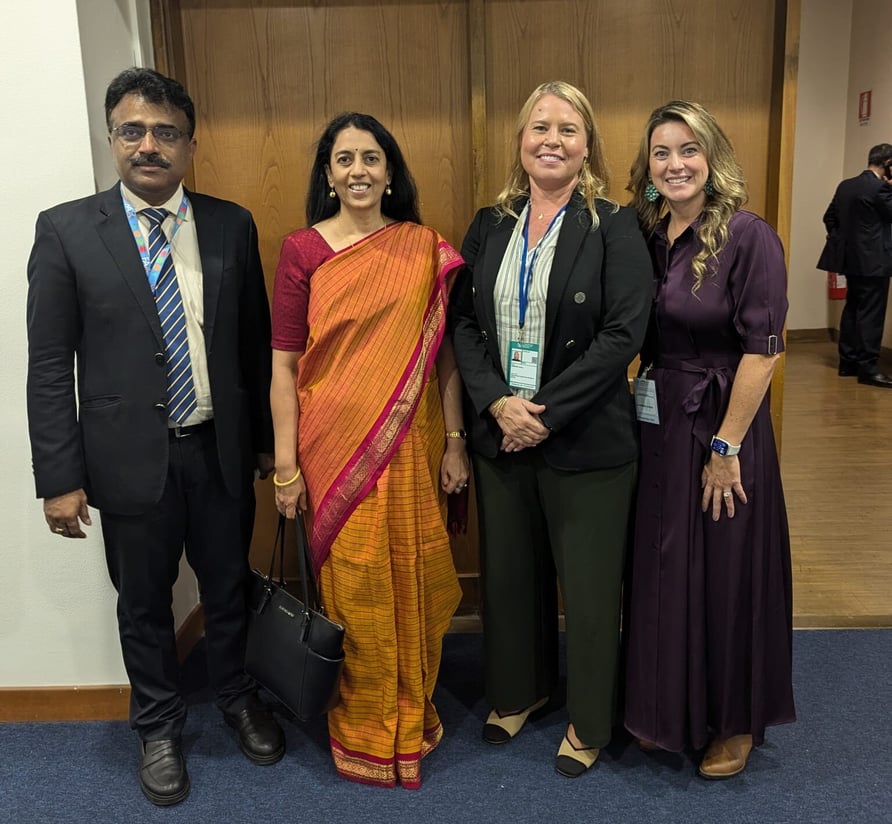
Left to right: Dr. Jujjavarapu Balaji, India’s Minister (Agriculture) to Rome; H.E. Vani Rao, India’s Ambassador to Italy; Giddens; Tara Vander Dussen, U.S. dairy farmer.
USDEC delegation travels to Oregon
A cross-departmental USDEC delegation was in Oregon this week meeting with members, farmers, and state and regional checkoff organizations. The three-day mission sought to deepen engagement and strengthen relationships with U.S. dairy export stakeholders. The delegation made stops at Tillamook County Creamery Association, Rogue Creamery, Don Froylan Creamery, the John Van Dam dairy farm and the Oregon Dairy Council. Among the many topics discussed, participants explored U.S. dairy export opportunities, what USDEC can do to meet member needs, and the role that niche products play in U.S. export growth.

The USDEC delegation and Tillamook staff on the member visit to Oregon.
Market Summary
WMP lifts GDT
The Global Dairy Trade (GDT) Price Index rose 1.2% on Oct. 1. It was the fifth increase in the last six auctions and second largest in that span, with growth driven primarily by WMP. The average winning WMP price increased 3.0% to US$3,559/MT, despite a strong start to the new New Zealand season creating potential headwinds. It was the highest price in two years (since Oct. 4, 2022).
North Asia (China) remained the No. 1 WMP buyer (and top customer overall), but WMP demand was strong across geographies.
Cheddar continued to rally as well, rising 3.8% to US$4,606/MT, despite Fonterra adding 100 MT to the 12-month forecast. It was the highest cheddar price since June 2023, up 8% since Aug. 20. For the second straight auction, Africa was the leading buyer followed by Southeast Asia.
Other products did not fare as well. AMF largely held steady (US$7,213/MT). Butter slipped 1.4% to US$6,407/MT, marking three straight declines. SMP took a step back, falling 0.6% to US$2,795/MT after strong showings at the previous three auctions. And after setting four consecutive price records, mozzarella gave back ground, falling 7.7% to US$4,960.
China optimism
The overall picture is largely a positive one, particularly given China’s upgraded presence on the platform for five straight auctions. One of the big questions though is how last week’s announcement of major new economic stimulus measures (the country’s biggest stimulus package since the early days of the pandemic) might affect both dairy supply and demand.
The collective stimulus plan is far-ranging, encompassing several measures to reduce borrowing costs, cut interest rates and support new lending. Additional actions specifically address issues in the domestic dairy sector—on both the supply and demand sides. Farmers will receive loan extensions/renewals and subsidies, consumers will get consumption vouchers, and students will get more government-purchased milk. However, exact details on the size and timing of the dairy outlays remain uncertain.
Market Access and Regulatory Affairs
USDEC makes 128 Export Guide document updates in September
The MARA team updated or revised 128 documents in the USDEC Export Guide last month. Here are some highlights:
Volume 1: Tariffs and Classification
- Colombia: Added information to U.S.-Colombia FTA reflecting additional 4.86% countervailing duty for milk powder (0402.10, 0402.21 and 0402.29).
Volume 2: Import Requirements
- Colombia: Updated U.S. Dairy Plant Registration or Approval section to reflect deadline extension for plant registration.
- Egypt: Updated Halal Certificate section to indicate enforcement delay through Dec. 31, 2025.
- Indonesia: Added new prior notification requirements.
- Turkey: Updated U.S. Dairy Plant Registration or Approval section to indicate that products for human consumption will be required to come from facilities included on the EU's approved establishments list starting Jan. 1, 2026.
Volume 3: Labeling and Product Standards
- Australia and New Zealand: Incorporated a major revision to the Infant Formula standard. Updated several documents, including: Food Additives, Food for Special Medical Purposes, General labeling, Novel Foods, and Pesticide and Veterinary Drug MRL’s in Milk and Prohibited Substances (Australia ONLY).
- China: Updated the Feed document (see contaminants section and appendix for updated sample feed label for whey powder).
- Thailand: In Labeling Requirements, added a new standard for labeling of pre-packaged foods and updated bulk labeling.
Every month, USDEC’s Market Access team emails a list of guide updates to interested members. If there is anyone at your company who should be included on the distribution list for that email in the future, please contact Jessica Smith at jsmith@usdec.org.
Company News
Fonterra announces strong results, revised strategy for growth
New Zealand-based Fonterra Co-operative Group Ltd. made several announcements last week related to its performance and future. While sharing its FY 2024 full year results, company officials said they are confident that demand from its Chinese market is improving, despite the country’s focus on increasing its domestic milk supply. Chair Peter McBride highlighted the downward pressure on China’s milk supply, compounded by aging inventories—particularly in whole milk powder. And CEO Miles Hurrell said Fonterra’s foodservice business in China is growing, despite the country’s broader economic challenges. He also attributed the expected demand comeback in part to the end of a surplus of domestically produced milk there.
Fonterra also released a revised strategy that focuses on its high-performing Ingredients and Foodservice businesses, following a strategic review that confirmed the co-op’s strengths as a B2B dairy nutrition provider. To create the most value and room for future growth, the new approach includes six “strategic choices,” including working alongside farmers to enable on-farm profitability and productivity, expanding its Foodservice business in China and other key markets to grow earnings, and investing in a manufacturing and supply chain network that allows flexibility to allocate milk to the highest returning product and sales channel. Other key points of its results reporting included the announcement of a 55 cent per share dividend and an increase of its forecast Farmgate Milk Price for the 2024-2025 season by 50 cents to a new midpoint range of NZ$9 per kgMS. (Company reports; Farmers Weekly, 9/27/24)
Beston Global Food enters voluntary administration
South Australian dairy company Beston Global Food Co. entered voluntary administration following an unsuccessful attempt to sell the company’s cheese and lactoferrin production facility to Japan-based Megmilk Snow Brands. Beston, which is known for its cream cheese and hard cheeses such as gruyere and parmesan, cited several factors for its financial difficulties, including post-pandemic debt and high operating costs caused by high energy and dairy prices. Financial services company KPMG began the voluntary administration process and has taken control of the business's assets, trading and day-to-day operations. (ABC Rural, 9/23/24)
Danone shares India investment plans
After pulling out of India’s dairy market six years ago, French dairy company Danone revealed plans for further investment in its nutrition products operations in the country. CEO Antoine de Saint-Affrique said Indian consumers will soon see more Danone products on shelves, and that it plans to invest €20 million (about US$22 million) over the next four years to expand its nutrition facility in Punjab. Danone will also launch a three-year dairy farmer program designed to “equip more than 5,000 smallholder dairy farmers in Punjab with sustainable farming methods and knowledge of resilient farming models.” (Just Food, 9/30/24)
Company Briefs
After two years of construction, operations began at Junlebao’s new dairy farm in Anhui Province. The Chinese dairy processor’s newest farm is capable of holding 10,000 dairy cows with estimated production of around 80,000 MT per year, much of which will reportedly be purchased by the local government to provide milk for the primary and secondary school students in the region. … Yum China announced the opening of a new supply chain center in Shanghai that includes room-temperature storage, low-temperature cold chain logistics and office space. A company official said Yum China needed to increase its supply chain capabilities to keep up with its plans to expand to 20,000 outlets by 2026. Currently, its Pizza Hut brand is trialing the delivery of pizza by drones in Shenzhen in cooperation with delivery company Meituan. … Canadian investment group CDPQ increased its stake in Canadian dairy company Saputo with an additional investment of CAN$378 (about US$280 million). CDPQ's stake in the company now totals approximatively 4.5%. (USDEC China Office; Company reports)
In Case You Missed It...
U.S. Dairy Exporter Blog
Market analysis, research and news subscribe hereUSDEC Twitter feed
Follow us here.